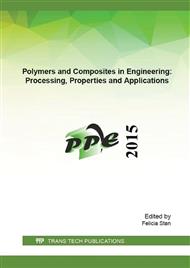[1]
C.S. Chen, M. Mrksich, S. Huang, G.M. Whitesides, D.E. Ingber, Geometric control of cell life and death, Science 276 (1997) 1425–28.
DOI: 10.1126/science.276.5317.1425
Google Scholar
[2]
Y.L. Wang, C.E. Sims, P. Marc, M. Bachman, G.P. Li, N.L. Allbritton, Micropatterning of living cells on a heterogeneously wetted surface, Langmuir 22 (2006) 8257-62.
DOI: 10.1021/la061602k
Google Scholar
[3]
H. Gau, S. Herminghaus, P. Lenz, R. Lipowsky, Liquid morphologies on structured surfaces: From microchannels to microchips, Science 283 (1999) 46-49.
DOI: 10.1126/science.283.5398.46
Google Scholar
[4]
L.B. Xu, W. Chen, A. Mulchandani, Y.S. Yan, Reversible conversion of conducting polymer films from superhydrophobic to superhydrophilic, Angew. Chem. Int. Ed. 44 (2005) 6009-12.
DOI: 10.1002/anie.200500868
Google Scholar
[5]
S.L. Tao, K.C. Popat, J.J. Norman, T.A. Desai, Surface modification of Su-8 for enhanced biofunctionality and nonfouling properties, Langmuir 24 (2008) 2631-36.
DOI: 10.1021/la703066z
Google Scholar
[6]
G. Caputo, B. Cortese, C. Nobile, M. Salerno, R. Cingolani, G. Gigli, P.D. Cozzoli, A. Athanassiou, Adv. Funct. Mater. 19 (2009) 1149-57.
DOI: 10.1002/adfm.200800909
Google Scholar
[7]
A. Athanassiou, M. I. Lygeraki, D. Pisignano, K. Lakiotaki, M. Varda, E. Mele, C. Fotakis, R. Cingolani, S.H. Anastasiadis, Photocontrolled variations in the wetting capability of photochromic polymers enhanced by surface nanostructuring, Langmuir 22 (2006).
DOI: 10.1021/la052122g
Google Scholar
[8]
F. Xia, L. Feng, S.T. Wang, T.L. Sun, W.L. Song, W.H. Jiang, L. Jiang, Dual-responsive surfaces that switch superhydrophilicity and superhydrophobicity, Adv. Mater. 18 (2006) 432-36.
DOI: 10.1002/adma.200501772
Google Scholar
[9]
Jeong H.E., Kwak M.K., Park C.I., Suh K.Y., Wettability of nanoengineered dual-roughness surfaces fabricated by UV-assisted capillary force lithography, J. Colloid Interface Sci. 339 (2009) 202-7.
DOI: 10.1016/j.jcis.2009.07.020
Google Scholar
[10]
Y. Kwon, N. Patankar, J. Choi, J. Lee, Design of surface hierarchy for extreme hydrophobicity, Langmuir, 25 (2009) 6129-36.
DOI: 10.1021/la803249t
Google Scholar
[11]
A. Pruna, J. Ramiro, L. Belforte, Preliminary study on different technological tools and polymeric materials towards superhydrophobic surfaces for automotive applications, J. Phys. Chem. Solids 74 (2013) 1640-45.
DOI: 10.1016/j.jpcs.2013.06.009
Google Scholar
[12]
T.G. Cha, J.W. Yi, M.W. Moon, K.R. Lee, H.Y. Kim, Nanoscale patterning of microtextured surfaces to control superhydrophobic robustness, Langmuir, 26 (2010) 8319-26.
DOI: 10.1021/la9047402
Google Scholar
[13]
A. Tropmann, L. Tanguy, P. Koltay, R. Zengerle, L. Riegger, Completely superhydrophobic PDMS surfaces for microfluidics, Langmuir 28 (2012) 8292-95.
DOI: 10.1021/la301283m
Google Scholar
[14]
D.S. Kim, B.K. Lee, J. Yeo, M.J. Choi, W. Yang, T.H. Kwon, Fabrication of PDMS micro/nano hybrid surface for increasing hydrophobicity, Microelectron. Eng. 86 (2009) 1375-78.
DOI: 10.1016/j.mee.2009.02.017
Google Scholar
[15]
X. Liu, C. Luo, Fabrication of super-hydrophobic channels, J. Micromech. Microeng. 20 (2010), 025029.
DOI: 10.1088/0960-1317/20/2/025029
Google Scholar
[16]
S. Guo, M. Sun, J. Shi, Y. Liu, W. Huang, C. Combellas, Y. Chen, Patterning of hydrophilic micro arrays with superhydrophobic surrounding zones, Microelectron. Eng. 84 (2007) 1673-76.
DOI: 10.1016/j.mee.2007.01.190
Google Scholar
[17]
X.S. Zhang, B.H. Jin, S.G. Chu, N. Peter, F.Y. Zhu, H.X. Zhang, Single-step fabrication of superhydrophobic micro/nano dual-scale PDMS film replicated from ultra-low-surface-energy mold, in: IEEE 26th International Conference on Micro Electro Mechanical Systems, Taiwan (2013).
DOI: 10.1109/memsys.2013.6474245
Google Scholar
[18]
E. Celia, T. Darmanin, E. Taffin de Givenchy, S. Amigoni, F. Guittard, Recent advances in designing superhydrophobic surfaces, J. Colloid Interface Sci. 402 (2013) 1-18.
DOI: 10.1016/j.jcis.2013.03.041
Google Scholar
[19]
M. Madou, Fundamentals of microfabrication. Boca Raton, CRC Press, (1997).
Google Scholar
[20]
V.K. Varadan, X. Jiang, V.V. Varadan, Microstereolithography and other fabrication techniques for 3D MEMS. Wiley, New York, (2001).
Google Scholar
[21]
H.K. Koponen, I. Saarikoski, T. Korhonen, M. Pääkkö, R. Kuisma, T.T. Pakkanen, M. Suvanto, T.A. Pakkanen, Modification of cycloolefin copolymer and poly(vinyl chloride) surfaces by superimposition of nano- and microstructures, Appl. Surf. Sci. 253 (2007).
DOI: 10.1016/j.apsusc.2006.11.039
Google Scholar
[22]
E. Puukilainen, T. Rasilainen, M. Suvanto, T.A. Pakkanen, Superhydrophobic polyolefin surfaces: controlled micro- and nanostructures Langmuir 23 (2007) 7263-68.
DOI: 10.1021/la063588h
Google Scholar
[23]
T.O. Yoon, H.J. Shin, S.C. Jeoung, Y.I. Park, Formation of superhydrophobic poly(dimethysiloxane) by ultrafast laser-induced surface modification, Opt. Express. 16 (2008) 12715-25.
DOI: 10.1364/oe.16.012715
Google Scholar
[24]
D. Copic, J.S. Park, S. Tawfick, M.F.L. De Volder, J.H. Hart, Fabrication of high-aspect-ratio polymer microstructures and hierarchical textures using carbon nanotube composite master molds, Lab. Chip. 11 (2011) 1831-37.
DOI: 10.1039/c0lc00724b
Google Scholar
[25]
H.E. Jeong, S.H. Lee, J.K. Kim, K.Y. Suh, Nanoengineered multiscale hierarchical structures with tailored wetting properties, Langmuir 22 (2006) 1640-45.
DOI: 10.1021/la0526434
Google Scholar
[26]
H.E. Jeong, R. Kwak, J.K. Kim, K.Y. Suh, Generation and self-replication of monolithic, dual-scale polymer structures by two-step capillary-force lithography, Small 4 (2008) 1913-18.
DOI: 10.1002/smll.200800151
Google Scholar
[27]
F. Zhang, J. Chan, H.Y. Low, Biomimetic hierarchical structures on polymer surfaces by sequential imprinting, Appl. Surf. Sci. 254 (2008) 2975-79.
DOI: 10.1016/j.apsusc.2007.10.061
Google Scholar
[28]
H.E. Jeong, M.K. Kwak, C.I. Park, K.Y. Suh, Wettability of nanoengineered dual-roughness surfaces fabricated by UV-assisted capillary force lithography, J. Colloid Interf. Sci. 339 (2009) 202-207.
DOI: 10.1016/j.jcis.2009.07.020
Google Scholar
[29]
M. Jin, X. Feng, J. Xi, J. Zhai, K. Cho, L. Feng, L. Jiang, Super-hydrophobic PDMS surface with ultra-low adhesive force, Macromol. Rapid Commun. 26 (2005) 1805–1809.
DOI: 10.1002/marc.200500458
Google Scholar
[30]
G. Davaasuren, C.V. Ngo, H.S. Oh, D.M. Chun, Geometric study of transparent superhydrophobic surfaces of molded and grid patterned polydimethylsiloxane (PDMS), Appl. Surf. Sci. 314 (2014) 530–536.
DOI: 10.1016/j.apsusc.2014.06.170
Google Scholar


